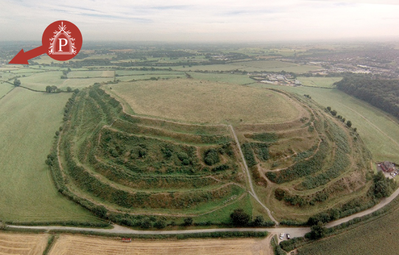As you'll probably know, if its an Iron age fort they usually consist of a series of concentric defensive ditch & wall rings, if its well preserved and you do a circular walk on top of the outermost wall, you should at some point come across a 'gap' in the wall, which will be the entrance. Follow this cut through the walls and ditches up to the top, and you've got a pre-made track up to the top. Occasionally they meandered between the walls, such as at Maiden Castle, but more usually its a single cut to the top, maybe with side ramparts.

The peak of hillfort building was in the Bronze / Celtic age, the millennium before the Romans. They fell into disuse during the Roman occupation of the first 5 centuries AD, as apart from the occasional rebellion the country was fairly peaceful and demilitarised. Many were then reused in the 'dark ages' from the mid 5th Century, when the Romans legions were recalled to defend the collapsing Empire, leaving Britain undefended. The Welsh borders were a hot-spot of conflict and forts were very likely to have been reused at this point, so I reckon your fort may have been reused between the 5th-8th Centuries. Firstly, the native Romano-Celts retreated West to Wales & Cornwall in face of the invading pagan Anglo Saxons (which is why the Welsh are the original natives, the English are more recent German arrivals). The Arthurian legends grew in the Welsh borders at this time, possibly from resistance by a Roman Christian general called Ambrosius Aurelianus. 'Camelot' was probably Cadbury Castle near us in Somerset, another reused hillfort.
Later on in the 8th Century there was trouble again in your bit, particularly from the aggressive expansion by Offa of Mercia, he fell out with the Welsh and just about everyone else. Its quite likely your fort was occupied at this time, so it might contain late dark age goodies, but most likely just exciting things like odd post holes and waste pits.
If you get it, do as much (academic) research as you can, although there's very little known about the history of the region from the dark ages, there are very few contemporary accounts. There might have been historic descriptions, surveys or folklore though. Place names can be quite a clue linking into historic events or characters, for example Oswestry is supposedly the site of where Oswald of Northumbria was lashed to a tree and dismembered. Nice. The trees are likely to be stabilising the soil and preventing erosion, so maintaining it as a wood is probably good for it. If theres the odd fallen tree, see if anything turns up in the root hole, but don't be tempted to get a metal detector and go digging, it would be illegal and you'd just cause damage- it needs a professional archaeologist to know what to look for or else its destroyed. You could try and get someone to do a Lidar survey, where a remote plane or drone maps the surface and produces a 3D map.
Its great to have a wood within a couple of miles, you can go every day and develop a real affinity with it. Your thinking is sound, mix of trees sounds good too. Mine is 3 miles away, one of its best features for us.
Have fun.
